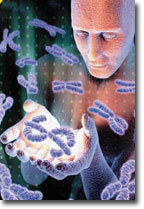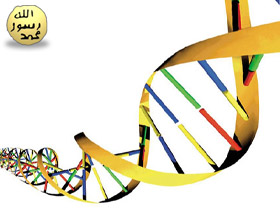From what thing did He create him? From a drop of sperm He created him and proportioned him. Then He eases the way for him. (Qur'an, 80:18-20)

The word "qaddarahu," translated as "proportioned" in the above verse, comes from the Arabic verb "qadare." It translates as "arranging, setting out, planning, programming, seeing the future, the writing of everything in destiny (by Allah)."
When the father's sperm cell fertilises the mother's egg, the parents' genes combine to determine all of the baby's physical characteristics. Each one of these thousands of genes has a specific function. It is the genes which determine the colour of the eyes and hair, height, facial features, skeletal shape and the countless details in the internal organs, brain, nerves and muscles. In addition to all the physical characteristics, thousands of different processes taking place in the cells and body-and indeed the control of the whole system-are recorded in the genes. For example, whether a person's blood pressure is generally high, low or normal depends on the information in his or her genes.
The first cell which forms when the sperm and the egg are joined also forms the first copy of the DNA molecule which will carry the code in every cell of the person's body, right up until death. DNA is a molecule of considerable size. It is carefully protected within the nucleus of the cell and this molecule is an information bank of the human body as it contains the genes we mentioned above. The first cell, the fertilised egg, then divides and multiplies in the light of the program recorded in the DNA. The tissues and organs begin to form: This is the beginning of a human being. The coordination of this complex structuring is brought about by the DNA molecule. This is a molecule consisting of atoms such as carbon, phosphorus, nitrogen, hydrogen and oxygen.
The information capacity recorded in DNA is of a size which astonishes scientists. There is enough information in a single human DNA molecule to fill a million encyclopaedia pages or 1,000 volumes. To put it another way, the nucleus of a cell contains information, equivalent to that in a 1 million-page encyclopaedia. It serves to control all the functions of the human body. To make a comparison, the 23-volumeEncyclopaedia Britannica, one of the largest encyclopaedias in the world, contains a total of 25,000 pages. Yet a single molecule in the nucleus of a cell, and which is so much smaller than that cell, contains a store of information 40 times larger than the world's largest encyclopaedias. That means that what we have here is a 1,000-volume encyclopaedia, the like of which exists nowhere else on Earth. This is a miracle of design and creation within our very own bodies, for which evolutionists and materialists have no answer.
Bearing in mind that the structure of DNA was unravelled by Francis Crick in 1953, it is truly amazing that the Qur'an pointed to the concept of "genetic planning" in an age when, as we have mentioned previously, mankind's knowledge was very limited. Geneticists were unable to discuss until the end of the 19th century and these remarkable facts act again as proofs that the Qur'an is the Word of Allah.


